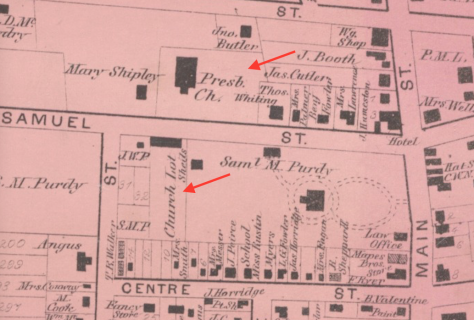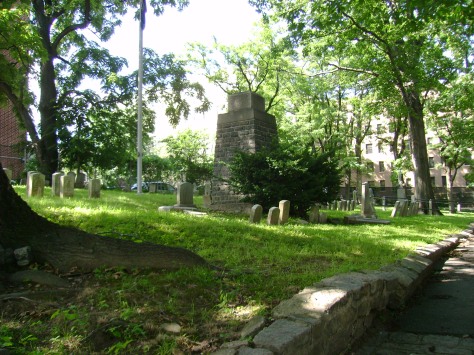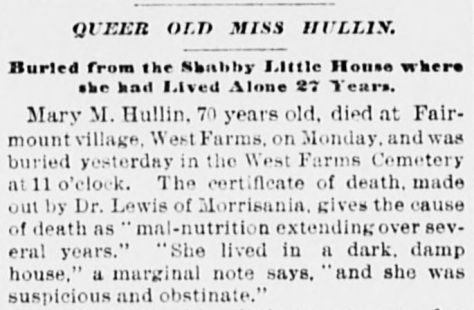
A keen-eyed observer passing by one of the buildings of the Lambert Houses, a massive, low-income residential complex near the Bronx Zoo, will find an odd detail. Bolted to the 1970s-era, orange-brick structure at the corner of Boston Road and East 180th Street is a mangled metal sign, its faded hand-painted lettering offering guidance to “West Farms Soldier Cemetery, Bronx Landmark, 1 Block West.” How and why this marker was placed on one of the megastructures at this troubled complex is a mystery—and one that will be lost as the Lambert Houses are currently being demolished and redeveloped. In any case, this curious public notice offers a delightful link between the modern, urban Bronx neighborhood of West Farms and the old rural village that is its namesake.
 Located at the corner of East 180th Street and Bryant Avenue, the burial ground known today as West Farms Soldier Cemetery is an oasis of calm near the edge of the Lambert Houses. Although 40 veterans of four wars—the War of 1812, the Civil War, the Spanish American War, and World War I—are interred here, the soldiers are only a part of a long and varied history of this cemetery, which served as a churchyard and a community cemetery beginning in the early 19th century.
Located at the corner of East 180th Street and Bryant Avenue, the burial ground known today as West Farms Soldier Cemetery is an oasis of calm near the edge of the Lambert Houses. Although 40 veterans of four wars—the War of 1812, the Civil War, the Spanish American War, and World War I—are interred here, the soldiers are only a part of a long and varied history of this cemetery, which served as a churchyard and a community cemetery beginning in the early 19th century.
In 1814, the trustees of the First Presbyterian Church of West Farms—then a “flourishing little village” of about 300 inhabitants, located 12 miles from New York City at the head of the Bronx River—acquired two parcels of land on Samuel Street (now 180th Street) to establish a church. The church, surrounded by a graveyard, was built in 1815 atop a hill on the north side of Samuel Street, about 200 feet west of the old Boston Post Road. The trustees designated part of the second parcel of land, located on the south side of Samuel Street, “a graveyard for strangers and black slaves.”

As West Farms began to grow in the 1820s, John Butler acquired a parcel on the east side of the Presbyterian churchyard to establish a larger cemetery to serve the West Farms community. Butler subdivided this parcel into burial lots that he sold directly to buyers. Though originally two separate burial grounds, over time Butler’s cemetery and the adjoining Presbyterian graveyard came to be seen as one site. By the early 20th century, some 200 individuals had been buried in the West Farms Cemetery, including 35 Civil War veterans. Most distinguished of these is Captain William J. Rasberry, who led his men into the Battle of Cedar Creek, Virginia, and died there, in 1864. The Rasberry family lived along what is today East 178th Street in West Farms.

The area surrounding West Farms Cemetery had developed into a bustling urban community by the early 1900s. With the changing times, the West Farms Presbyterian Church abandoned its hilltop sanctuary and moved to a new building constructed on the church-owned lot on the opposite side of 180th Street. This building, Beck Memorial Presbyterian Church, still stands today. The original church building was used as a gymnasium and recreation hall until it was destroyed by fire in 1948.
Grading and widening of streets in West Farms during the first decade of the 20th century disturbed graves in the cemetery next to the old Presbyterian church building as well as in the forgotten paupers’ burial ground on the south side of East 180th Street. When the public learned that soldiers graves were being neglected and desecrated in the West Farms Cemetery, a committee was founded to protect the site. The committee re-dedicated the cemetery as the West Farms Soldier Cemetery in 1910, and raised funds to improve the property, erect a Civil War monument, and have soldiers’ remains transferred to West Farms from burial grounds at Fort Schuyler and from the Potter’s Field at Hart Island. The final interment at the West Farms Cemetery, of World War I veteran Valeriano J. Tolosa, took place in 1929. The city assumed possession of the cemetery in 1954 and designated it a historic landmark in 1967. Today the roughly one-acre site, surrounded by an eight-foot-high iron fence, is under the care of the NYC Department of Parks and Recreation.





View more photos of West Farms Soldier Cemetery
Sources: Beers’ 1868 Atlas of New York and Vicinity, Pl. 13; Hyde’s 1901 Atlas of the borough of the Bronx, Vol. 2, Pl. 8; The Story of The Bronx (Jenkins 1912), 281, 392; The Borough of the Bronx…(Cook 1913), 143-145; “Description of West-Farms,” Daily National Intelligencer, Apr 28, 1813;“Workmen Unearth Skeletons,” New York Times, Jun 19, 1900; “Harlem and the Bronx,” Brooklyn Daily Eagle, Jun 26, 1900; “Dug Up Human Bones,” Brooklyn Daily Eagle, Aug 16, 1900; “Harlem and the Bronx,” Brooklyn Daily Eagle, Sep 14, 1900; “Cutting Through a Cemetery,” New York Times, Sep 16, 1900; “Robbed of His Grave,” New York Times, Mar 5, 1909; “Veterans at Unveiling,” New York Tribune, May 30, 1910; “Take Soldier Dead from Pauper Field,” New York Times, May 29, 1916; “134 Year Old Building of Bronx Church Burns,” New York Times, Jan 11, 1948; “City Will Acquire Soldier Cemetery,” New York Times, May 6, 1954; Old West Farms Soldier Cemetery Designation Report (Landmarks Preservation Commission 1967); Archaeological Monitoring at the Old West Farms Soldier Cemetery (Parsons Engineering 2000); “What Lies Beneath: Cemeteries of the Bronx,” Bronx County Historical Society exhibit, Oct 2017; Cemeteries of the Bronx (Raftery 2016), 267-280
